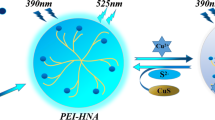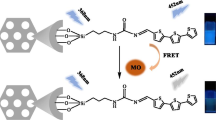Abstract
A novel colorimetric/fluorescent dual-mode nanosensor for Hg2+ detection was constructed using expanded mesoporous silica (EMSN)-encapsulated ultrasmall platinum nanoclusters (EMSN@Pt NCs) with improved peroxidase-like and stable fluorescent activities. The sensing technique was based on the mechanism that the peroxidase mimetic activity and fluorescence intensity of EMSN@Pt NCs can be inhibited in the presence of Hg2+. In this sensing platform, a linear range of 5–50 nM with a detection limit of 1.78±0.38 nM and quantification limit of 5.93 nM was obtained via fluorescent analysis. A linear calibration curve from 0.25 to 200 nM with a detection limit of 8.25±0.51 nM and quantification limit of 27.47 nM was achieved via colorimetric analysis. The proposed dual-mode probe possesses excellent selectivity and reliability for Hg2+ detection, which can function as an efficient nanosensor for the quantitative determination of Hg2+ in Pueraria lobata.
Graphical abstract








Similar content being viewed by others
References
Aragay G, Pons J, Merkoçi A (2011) Recent trends in macro-, micro-, and nanomaterial-based tools and strategies for heavy-metal detection. Chem Rev 111(5):3433–3458
Risher JF, De Rosa CT, Jones DE, Murray HE (1999) Summary report for the expert panel review of the toxicological profile for mercury. Toxicol Ind Health 15(5):483–516
Lei Y-M, Wen R-X, Zhou J, Chai Y-Q, Yuan R, Zhuo Y (2018) Silver ions as novel coreaction accelerator for remarkably enhanced electrochemiluminescence in a PTCA–S2O82–system and its application in an ultrasensitive assay for mercury ions. Anal Chem 90(11):6851–6858
Trasande L, Landrigan PJ, Schechter C (2005) Public health and economic consequences of methyl mercury toxicity to the developing brain. Environ Health Persp 113(5):590–596
Sun B, Jiang X, Wang H, Song B, Zhu Y, Wang H, Su Y, He Y (2015) Surface-enhancement Raman scattering sensing strategy for discriminating trace mercuric ion (II) from real water samples in sensitive, specific, recyclable, and reproducible manners. Anal Chem 87(2):1250–1256
Vicentino PdO, Brum DM, Cassella RJ (2015) Development of a method for total Hg determination in oil samples by cold vapor atomic absorption spectrometry after its extraction induced by emulsion breaking. Talanta 132:733–738
Sener G, Uzun L, Denizli A (2014) Lysine-promoted colorimetric response of gold nanoparticles: a simple assay for ultrasensitive mercury (II) detection. Anal Chem 86(1):514–520
Zhu S, Chen B, He M, Huang T, Hu B (2017) Speciation of mercury in water and fish samples by HPLC-ICP-MS after magnetic solid phase extraction. Talanta 171:213–219
Shi Y, Chen N, Su Y, Wang H, He Y (2018) Silicon nanohybrid-based SERS chips armed with an internal standard for broad-range, sensitive and reproducible simultaneous quantification of lead (II) and mercury (II) in real systems. Nanoscale 10(8):4010–4018
Yao J, He Y, Li L, Li P, Yang M (2019) Magnified fluorescent aptasensors based on a gold nanoparticle− DNA hybrid and DNase I for the cycling detection of mercury (II) Ions in aqueous solution. Ind Eng Chem Res 58(47):21201–21207
Xavier SSJ, Karthikeyan C, Kim AR, Yoo DJ (2014) Colorimetric detection of melamine using β-cyclodextrin-functionalized silver nanoparticles. Anal Methods 6(20):8165–8172
Xianyu Y, Xie Y, Wang N, Wang Z, Jiang X (2015) A dispersion-dominated chromogenic strategy for colorimetric sensing of glutathione at the nanomolar level using gold nanoparticles. Small 11(41):5510–5514
Kirubaharan CJ, Kalpana D, Lee YS, Kim A, Yoo DJ, Nahm KS, Kumar GG (2012) Biomediated silver nanoparticles for the highly selective copper (II) ion sensor applications. Ind Eng Chem Res 51(21):7441–7446
Xavier SSJ, Ranjani M, Yoo DJ, Archana V, Charles L, Annaraj J (2019) Environmentally benign carbon nanodots prepared from lemon for the sensitive and selective fluorescence detection of Fe (III) and tannic acid. J Fluoresc 29(3):631–643
Ramachandran K, Kalpana D, Sathishkumar Y, Lee YS, Ravichandran K (2016) A facile green synthesis of silver nanoparticles using Piper betle biomass and its catalytic activity toward sensitive and selective nitrite detection. J Ind Eng Chem 35:29–35
Ranjani M, Sathishkumar Y, Lee YS, Yoo DJ, Kim AR (2015) Ni–Co alloy nanostructures anchored on mesoporous silica nanoparticles for non-enzymatic glucose sensor applications. RSC Adv 5(71):57804–57814
Guo X, Chen F, Wang F, Wu Y, Ying Y, Wen Y, Yang H, Ke Q (2020) Recyclable Raman chip for detection of trace Mercury ions. Chem Eng J 390:124528
Katowah DF, Alqarni S, Mohammed GI, Al Sheheri SZ, Alam M, Ismail SH, Asiri AM, Hussein MA, Rahman MM (2020) Selective Hg2+ sensor performance based various carbon-nanofillers into CuO-PMMA nanocomposites. Polym Advan Technol 31(9):1946–1962
Rahman MM, Alamry KA, Awual MR, Mekky AE (2020) Efficient Hg (II) ionic probe development based on one-step synthesized diethyl thieno [2, 3-b] thiophene-2, 5-dicarboxylate (DETTDC2) onto glassy carbon electrode. Microchem J 152:104291
Rahman MM, Alenazi NA, Hussein MA, Alam M, Alamry KA, Asiri AM (2018) Hybride ZnCdCrO embedded aminated polyethersulfone nanocomposites for the development of Hg2+ ionic sensor. Mater Res Express 5(6):065019
Hussain MM, Rahman MM, Arshad MN, Asiri AM (2017) Hg2+ sensor development based on (E)-N′-nitrobenzylidene-benzenesulfonohydrazide (NBBSH) derivatives fabricated on a glassy carbon electrode with a nafion matrix. ACS Omega 2(2):420–431
Khan A, Asiri AM, Khan AAP, Rub MA, Azum N, Rahman MM, Khan SB, Alamry KA, Ab Ghani S (2013) Sol–gel synthesis and characterization of conducting polythiophene/tin phosphate nano tetrapod composite cation-exchanger and its application as Hg (II) selective membrane electrode. J Sol-Gel Sci Technol 65(2):160–169
Awual MR, Hasan MM, Eldesoky GE, Khaleque MA, Rahman MM, Naushad M (2016) Facile mercury detection and removal from aqueous media involving ligand impregnated conjugate nanomaterials. Chem Eng J 290:243–251
Khan A, Khan AAP, Rahman MM, Asiri AM, Alamry KA (2015) Preparation of polyaniline grafted graphene oxide–WO 3 nanocomposite and its application as a chromium (iii) chemi-sensor. RSC Adv 5(127):105169–105178
Wang C, Wang Y, Shi H, Yan Y, Liu E, Hu X, Fan J (2019) A strong blue fluorescent nanoprobe for highly sensitive and selective detection of mercury (II) based on sulfur doped carbon quantum dots. Mater Chem Phys 232:145–151
Cui W-R, Zhang C-R, Jiang W, Liang R-P, Wen S-H, Peng D, Qiu J-D (2019) Covalent organic framework nanosheet-based ultrasensitive and selective colorimetric sensor for trace Hg2+ detection. ACS Sustain Chem Eng 7(10):9408–9415
Tao Y, Ju E, Ren J, Qu X (2015) Bifunctionalized mesoporous silica-supported gold nanoparticles: intrinsic oxidase and peroxidase catalytic activities for antibacterial applications. Adv Mater 27(6):1097–1104
Lin KJ, Chen LJ, Prasad MR, Cheng CY (2004) Core–shell synthesis of a novel, spherical, mesoporous silica/platinum nanocomposite: Pt/PVP@ MCM-41. Adv Mater 16(20):1845–1849
Arbiol J, Cabot A, Morante J, Chen F, Liu M (2002) Distributions of noble metal Pd and Pt in mesoporous silica. Appl Phys Lett 81(18):3449–3451
Khan HA, Iqbal MI, Jaleel A, Abbas I, Abbas SA, Deog-Jung K (2019) Pt encapsulated hollow mesoporous SiO2 sphere catalyst for sulfuric acid decomposition reaction in SI cycle. Int J Hydrogen Energy 44(4):2312–2322
Li H, Liu H, Zhang J, Cheng Y, Zhang C, Fei X, Xian Y (2017) Platinum nanoparticle encapsulated metal–organic frameworks for colorimetric measurement and facile removal of mercury (II). ACS Appl Mater Int 9(46):40716–40725
Li W, Chen B, Zhang H, Sun Y, Wang J, Zhang J, Fu Y (2015) BSA-stabilized Pt nanozyme for peroxidase mimetics and its application on colorimetric detection of mercury (II) ions. Biosens Bioelectron 66:251–258
Li M, Lv J, Wang S, Wang J, Lin Y (2020) Expanded mesoporous silica-encapsulated ultrasmall Pt nanoclusters as artificial enzymes for tracking hydrogen peroxide secretion from live cells. Anal Chim Acta 1104:180–187
Josephy PD, Eling T, Mason RP (1982) The horseradish peroxidase-catalyzed oxidation of 3, 5, 3', 5'-tetramethylbenzidine. Free radical and charge-transfer complex intermediates. J Biol Chem 257 (7):3669-3675
Wu G-W, He S-B, Peng H-P, Deng H-H, Liu A-L, Lin X-H, Xia X-H, Chen W (2014) Citrate-capped platinum nanoparticle as a smart probe for ultrasensitive mercury sensing. Anal Chem 86(21):10955–10960
Acknowledgements
The authors gratefully acknowledge the financial support from the Postdoctoral Fund of Hebei Medical University, Postdoctoral Fund of Hebei Province (B2021003040), the Natural Science Foundation of Hebei Province (No. H2020206416, B2021206005, B2019206437), the Youth Top Talent Project of Hebei Province Higher Education (No. BJ2021050, BJ2020034), and Chunyu Project Outstanding Youth Fund of Hebei Medical University (No. CYYQ2021003, CYYQ201903).
Author information
Authors and Affiliations
Corresponding author
Ethics declarations
Conflict of interest
The authors declare no competing interests.
Additional information
Publisher's Note
Springer Nature remains neutral with regard to jurisdictional claims in published maps and institutional affiliations.
Yanting Shen and Yuhui Zhao are contributed equally
Supplementary Information
Below is the link to the electronic supplementary material.
Rights and permissions
About this article
Cite this article
Shen, Y., Zhao, Y., Zhu, Y. et al. Fluorescence-active and peroxidase-like expanded mesoporous silica-encapsulated ultrasmall Pt nanoclusters: a novel colorimetric/fluorescent dual-mode nanosensor for sensitive detection of mercury in medicinal and edible Pueraria lobata. Microchim Acta 189, 18 (2022). https://doi.org/10.1007/s00604-021-05119-y
Received:
Accepted:
Published:
DOI: https://doi.org/10.1007/s00604-021-05119-y




